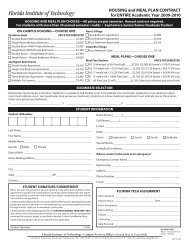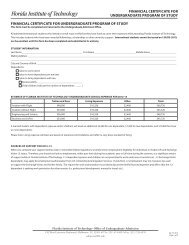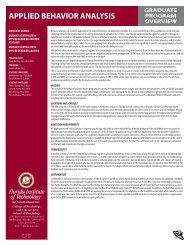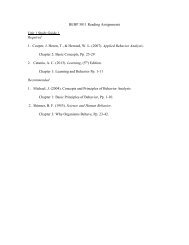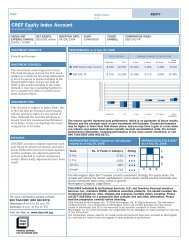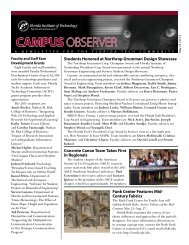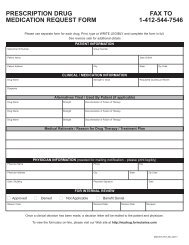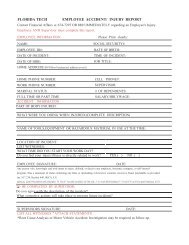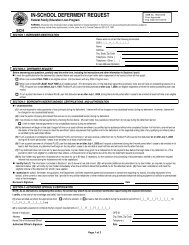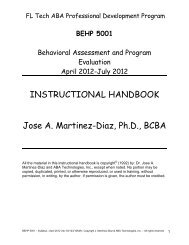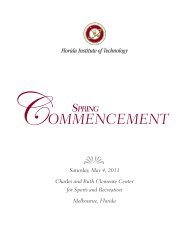2008–2009 - Florida Institute of Technology
2008–2009 - Florida Institute of Technology
2008–2009 - Florida Institute of Technology
Create successful ePaper yourself
Turn your PDF publications into a flip-book with our unique Google optimized e-Paper software.
counted from admission into the doctoral program. The written<br />
portion <strong>of</strong> the examination consists <strong>of</strong> individual examinations<br />
given by each member <strong>of</strong> the advisory committee. These written<br />
examinations are intended to cover each <strong>of</strong> the student’s areas <strong>of</strong><br />
specialization. The written portion <strong>of</strong> the comprehensive examination<br />
is followed by an oral component administered by the<br />
student’s advisory committee. The oral examination provides the<br />
advisory committee an opportunity to complete the examinations<br />
in each <strong>of</strong> the student’s specialty areas. Subsequent to completion<br />
<strong>of</strong> both written and oral components <strong>of</strong> the examination, a<br />
dissertation proposal must be submitted to the student’s advisory<br />
committee for evaluation. Upon determining that the proposed<br />
research is <strong>of</strong> doctoral quality and that completion is feasible, the<br />
student is advanced to candidacy for the doctoral degree.<br />
Course Work and Dissertation Summary<br />
Doctoral course work minimum beyond master’s degree .........................18<br />
Doctoral research and dissertation ...........................................................24<br />
TOTAL MINIMUM BEYOND THE MASTER’S DEGREE .................42<br />
General degree requirements are presented in the Academic<br />
Overview section <strong>of</strong> this catalog.<br />
Curriculum<br />
The student’s master’s and doctoral course work combined<br />
should include a minimum <strong>of</strong> 24 credit hours in mechanical<br />
engineering and 12 credit hours in mathematics. The doctoral<br />
program <strong>of</strong> study must be approved by the student’s adviser and<br />
the department head. The distribution <strong>of</strong> these courses should<br />
include courses in each <strong>of</strong> the three optional areas <strong>of</strong> specialization<br />
(excluding biomedical engineering, which can be used as a<br />
related area <strong>of</strong> specialization), and as a minimum should have the<br />
credit distribution given below:<br />
Major Area <strong>of</strong> Specialization (including master’s courses) .......................18<br />
Related Areas <strong>of</strong> Specialization (including master’s courses) ..........9 (each)<br />
Mathematics (including master’s courses) ...............................................12<br />
reSeArch<br />
Mechanical and aerospace engineering facilities include laboratories<br />
for energy research, fluid mechanics and aerodynamics,<br />
combustion and propulsion, metallurgy and solid mechanics,<br />
system dynamics and control, instrumentation and applied laser<br />
research, computer-aided design and computational research.<br />
Other laboratories around the campus can also be used by<br />
mechanical engineering graduate students performing advanced<br />
research.<br />
Funded research activities <strong>of</strong> mechanical and aerospace engineering<br />
faculty have recently included studies <strong>of</strong> efficient heat<br />
transfer/insulation mechanisms in building environments,<br />
advanced HVAC and fuel cell systems, integration <strong>of</strong> renewable<br />
energy sources into residential and utility applications, computation<br />
<strong>of</strong> radiative transport, computational mechanics with<br />
emphasis on nano-devices and damage mechanisms in laminated<br />
composite structures, development <strong>of</strong> experimental techniques<br />
for mechanical behavior <strong>of</strong> advanced materials systems, biomechanics,<br />
laser applications in bioengineering, turbulent boundary-layer<br />
structure, condition monitoring and fault diagnosis in<br />
rotating machinery and turbulent transport <strong>of</strong> moisture contained<br />
in air streams. Other studies have involved combustion in porous<br />
media, novel spatial and spherical mechanisms for part-orienting<br />
tasks, design and control <strong>of</strong> mobile robots, response <strong>of</strong> occupants<br />
in automobile collisions, smart composite structures with<br />
embedded sensors and optimization <strong>of</strong> composites. Research<br />
projects have been variously supported through grants from<br />
NASA, National Science Foundation, Defense Nuclear Agency,<br />
Air Force Office <strong>of</strong> Scientific Research, Edith Bush Charitable<br />
Foundation, <strong>Florida</strong> Solar Energy Center, <strong>Florida</strong> Space Grant<br />
Consortium, Department <strong>of</strong> Energy and a number <strong>of</strong> industrial<br />
affiliations.<br />
Laboratories include the Robotics and Spatial Systems Laboratory<br />
(RSSL); Laser, Optics and Instrumentation Laboratory (LOIL);<br />
Fluid Dynamics Laboratory and the Aerospace Structures<br />
Laboratory. RSSL is equipped with several industrial robots as<br />
well as a state-<strong>of</strong>-the-art autonomous mobile robot. In LOIL, the<br />
current technologies in continuous wave and short-pulse lasers<br />
and optics are used to develop new techniques for measuring and<br />
characterizing material properties for biomedical and material<br />
processing applications. The Fluid Dynamics Laboratory features<br />
a low-speed, low-turbulence wind tunnel <strong>of</strong> open-return type,<br />
with a square test section 0.535 m on a side and 1.6 m long. The<br />
speed range is from zero to 42 m/s. The mean turbulence level<br />
is a few hundredths <strong>of</strong> one percent at the lowest tunnel speeds.<br />
The Aerospace Structures Laboratory features a drop-tower for<br />
impact testing <strong>of</strong> structures and materials. This laboratory also<br />
has a shaker table for the vibration testing <strong>of</strong> structures. There<br />
are also ovens, vacuum pumps and other paraphernalia needed<br />
for the custom preparation <strong>of</strong> material specimens from advanced<br />
composite materials.<br />
See the Institution Overview section <strong>of</strong> this catalog for further<br />
information regarding the Dynamic Systems and Controls<br />
Laboratory; the Laser, Optics and Instrumentation Laboratory;<br />
and the Robotics and Spatial Systems Laboratory.<br />
Degree Programs—College <strong>of</strong> Engineering 97



